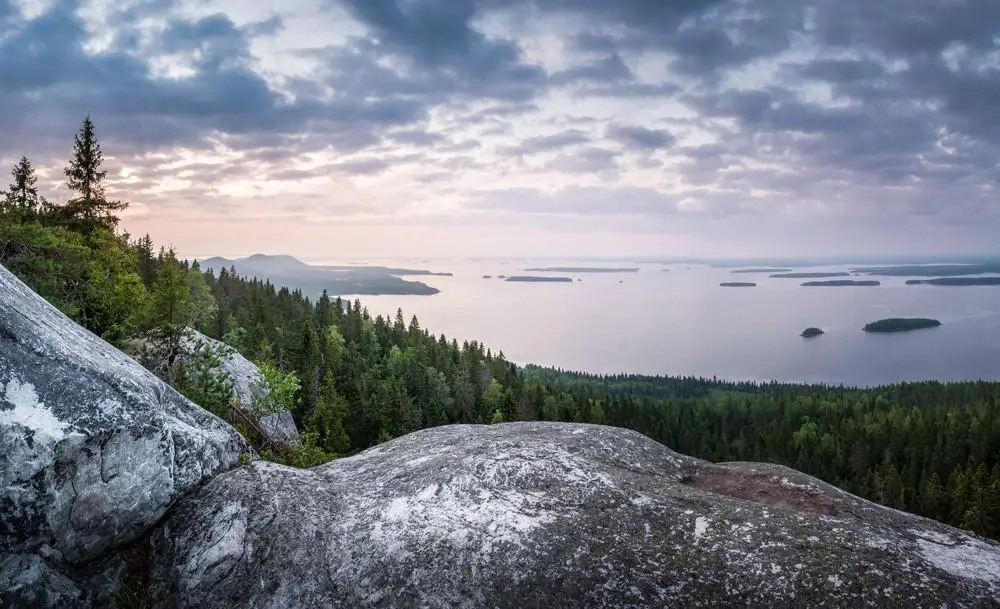A “Land of a Thousand Lakes”? Some Finns are of the opinion that this figure is still far understated. No one has counted the lakes in Finland exactly, but this Scandinavian region has much more to offer than just its cool waters. This is a world full of archipelagos with blood-red wooden houses, interesting coastal towns, wilderness trails, raging torrents and traces of history.
Finland is also the bright nights of summer, the distant high moors in Lapland, the melancholy of Karelian villages and the sympathetic way of life of the people in the far north. If you want to lift the veil of secrets of this country, you should go on a round trip. Where there are lakes, there are of course islands. There are said to be exactly 6329 in Finland, and each one is a pearl of nature with an aura of peace. Suitable for beautiful holidays away from any tourist crowds.

The Finns are said to be stubborn. Presumably, the roots of this penchant for individuality and seclusion are to be found in the history of the country. The historical resistance against foreign powers has apparently given this people the strength to defend itself and at the same time to rest in itself. Anyone who travels through Finland encounters above all a great hospitality. Although it has to grow, when it unfolds, the holidaymaker is accompanied by the “Hyvää matkaa” – the wish for a “good journey”.
Finland is the refuge for migratory birds and water rats. However, the cool charm of the north probably wafts towards the guests as soon as they arrive in the capital Helsinki . In the early 19th century, a Berlin architect named Carl Ludwig Engel gave the facades of the Finnish metropolis an unmistakable face. He opted for an urban layout analogous to a chessboard and for the classicist style of his time. Most of the buildings that are still polished today were built on Unioninkatu Street. Among other things, the Nikolai Cathedral with its Corinthian columns and a dome. This laid the foundation for Finland’s “white city”. But also worth seeing in Helsinki is the Rock Church in the Etu-Töölö district with its unique acoustics.

Helsinki has been named the European Capital of Culture, and it owes this to its distinctive and sometimes idiosyncratic design. The hub for onlookers and locals is the lively harbour of the city, from where the boats depart for the popular Suomenlinna archipelago, among other places. The Esplanadi is Helsinki’s boulevard, lined with a shopping paradise. The meeting place for many city dwellers is the Tsar’s Monument on Senate Square. And if you leave the periphery of Helsinki, you will be immersed in the incomparable nature of this country, as the wooded hills and quiet lakes reach all the way to the city limits.
This country is wild with its wonderful mosaic of forest and water. This is the territory of bears, wolves, wolverines, lynxes and flying squirrels. The brown bear is still the national symbol of Finland. He was even worshipped as a deity in some parts of the country until the 18th century. The sparsely populated tundra of Lapland is the gateway to the Arctic Circle and is blessed with numerous nature reserves and national parks. On cold winter days, holidaymakers can even spend the night in a snow hotel or an igloo and enjoy romantic dog sledding rides. Pyhä and Luosto are popular ski resorts because of their guaranteed snow.
Turku is Finland’s oldest city, and because of the Swedish minority, all signs there are bilingual. The locals call their small metropolis “Abo”, which translates as “city on the water”. Turku’s river is called “Aura”, and on its banks the city presents itself from its best side with a promenade and a harbour for sailors. But also interesting is the district of Port Arthur, which was created in an era when Finland was still part of the Russian Empire.
Travel information Finland
| Capital | Helsinki |
|---|---|
| Form of government | parliamentary republic parliamentary democracy |
| Currency | Euro (EUR) |
| Area | approx. 338,448 km² |
| Population | approx. 5,503,000 (2016) |
| Languages | Finnish |
| Electricity grid | 230 volts, 50 Hz |
| Area code | +358 |
| Time zone | UTC+2 EET UTC+3 EEST (March to October) |
Können wir Ihnen helfen?
Benötigen Sie Unterstützung bei Ihrer Reiseplanung oder weitergehende Informationen zu einzelnen Reisezielen? Wir freuen uns über Ihre Kontaktaufnahme.


